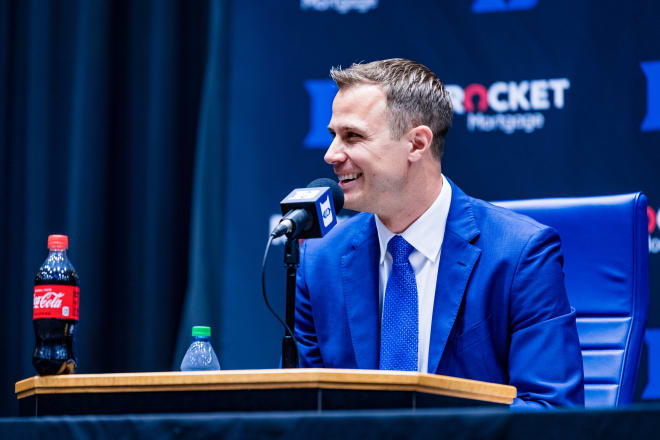Chicago trip brings Blue Devils closer together
Duke’s basketball team took a trip to Jon Scheyer’s hometown for some chemistry building and bonding

DURHAM – There were a few potential destinations for Duke’s men’s basketball team to go for a three-day weekend.
Really though, there was just one option.
“You didn’t get this from me but Jon Scheyer thinks Chicago is the greatest place on earth,” associate head coach Jai Lucas said with a laugh. “So that trip was only going one place. There were other cities on the table but once he said these are the three cities and Chicago was one of them, it didn’t matter who voted what.”
Scheyer and the Blue Devils went to Chicago about a month ago as a means to get out of the summer workout doldrums. There were visits with business leaders, a trip to the Chicago Board Operations Exchange where the team rang the bell, took a boat tour of Lake Michigan, and more.
It just so happens that Duke’s second-year coach grew up in a Chicago suburb (Northbrook, Ill.).
“I think I have the respect a little more for understanding what a great city Chicago is. I don’t know that I had the respect in the beginning,” Scheyer said. “About halfway through the trip, I heard some guys walking down the street, ‘Oh, you know, I would do Chicago again. Chicago’s pretty good.’”
Along with the sightseeing and experiential meetings, Scheyer appreciated that several former players spent time with the team. Among them were members of the 2015 national championship team in Grayson Allen, Quinn Cook, Matt Jones and Jahlil Okafor, and there was a surprise appearance by Jayson Tatum.
“What he’s meant to Duke, what he’s meant for our program,” Scheyer said of Tatum, “it’s a big-time thing when somebody does something without even asking, and that’s what he did in that case.”
There’s a lot more familiarity within Scheyer’s second team than his first. A year ago at this time, the only two returning scholarship players on the roster were Jeremy Roach and Jaylen Blakes.
Duke’s four-man freshman class is blending with eight returners ahead of this season. It’s not as seamless as bringing everybody back, but there is more of a foundation.
“We kind of put together this trip with the idea of getting away from here,” Scheyer said Wednesday afternoon at Cameron Indoor Stadium. “Just to bond, connect, learn, grow. It went even better than I could have imagined.”
It was in the business meetings where associate head coach Chris Carrawell was taken aback.
The Blue Devils met with Chris Kempczinski, a Duke alum and McDonald’s CEO, former secretary of education Arne Duncan, John Rogers Jr., founder of Ariel Investments, which is the country’s largest minority-run investment firm.
“Now, these guys are exposed to so many different things, you throw NIL in there, these guys are brands already when they come in,” Carrawell said. “And they want to know. The questions they were asking, I’m like, ‘These guys are 18, 19 years old.’ … Just their mind, the way they think now, it’s totally different, the way they think now.”
Duke will be back in Chicago in due time; that’s where this year’s Champions Classic will be held, with the Blue Devils facing Michigan State on Nov. 14.
Canceled NIL opportunity
The only negative, seemingly, about the Blue Devils’ trip to Chicago was a pickup game that was nixed because the NCAA had a change of heart.
Duke’s players were going to participate in a pickup game, meet and greet, cocktail hour and dinner with fans who had paid $2,500. The event, dubbed 312 Run, was nixed on the eve of the trip because of NCAA concerns under its NIL policies, per Forbes.
The program was initially told the game wouldn’t violate policies — so you can understand the frustration when it was upended a few days before the scheduled event.
“It’s frustrating when you try to do things the right way,” Scheyer said. “And you try to put your guys in a position where they have an opportunity to take advantage of their NIL the best way they can.
“I think the hardest part in all of this is you don’t know what you can and can’t do. There’s a lot of gray.”
Changing tones into a hypothetical, Scheyer alluded to something being a “yes” three months ago that turns into a “no” today.
It’s constantly evolving, he said, which is the toughest part of the NIL landscape for coaches and administrations to navigate.
“The goal line continues to move,” Scheyer said. “… End of the day, just tell us what we can and can’t do.”

